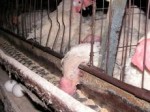Animal Factories

With the holidays approaching and meat being such a rooted component in most celebratory traditions, factory farms are busier than ever. Many people choose to eat animals raised in these inhumane conditions not because they’re cruel, but because they’re unaware of the severity of the horrible conditions in these animal factories.
In order to run a more efficient facility, factory farm institutions must resort to inhumane practices to help increase output and decrease cost. These practices are at the expense of animals – or machines, as many farms like to think of them.
The irony of the situation is that factory farming initially started as a method to provide food security and was seen as beneficial for the animals and the population of Great Britain. Stated in past articles from unsystem.org, the idea was that mass-producing meat would lessen the possibility of a food shortage. However, in recent years, Britain has grown increasingly weary of factory farming, following outbreaks of mad cow and foot-and-mouth disease.
Although the practices of factory farming may be despicable, this does not mean that the world’s population should become vegetarian. People simply need to be more aware of what is going into their bodies and be more aware of healthier alternatives to meat from factory farms. It is difficult – but not impossible – to find meat (especially poultry) which does not come from a factory farm-where virtually all birds raised for food live.
The defining characteristic of a factory farm is its confined living quarters called CAFOs (controlled animal feeding operations) for its residents, which typically include cows, hogs, turkeys or chickens. This poses many ethical issues. The animals are forced to live in their own excrement, giving way to numerous diseases, according to veganoutreach.org. Also, the situation is even worse for the birds and piglets on the bottom of a stack of cages. They end up covered in waste from the animals in cages above them, sometimes for up to two years.
Factory farmers’ biggest goal is to produce as much of their goods as possible by whatever means necessary. According to familyfarmdefenders.org, this often means utilizing bovine growth hormone (BGH), making animals obese to the point of not being able to hold up their own weight and causing their legs to break. The same growth hormone has made turkeys so obese that they often die of heart failure and lose the ability to reproduce naturally.
Instances that render an animal useless lead to their extermination by the fastest possible method. Male chicks have no economic value due to artificial insemination. This sentences them to be gassed by the hundreds or macerated (ground up alive), which is factory farms’ most common method of disposal.
In light of the killing of nine billion chickens (known as broiler chickens) for their flesh and the caging of 245 million hens for their eggs per year, it can be argued that chickens are the most abused animals on the planet. Usually by the time egg-laying chickens reach the slaughterhouse, their bodies are so emaciated and deprived of nutrients the only use of their flesh is for chicken noodle soup or canned, boned and diced meat, according to a 2003 edition of Poultry Times. The same publication also reports that the majority of the meat that is used by the National School Lunch Program is the scraps from these heavily mistreated birds.
The transport to the slaughterhouse is often the most harmful aspect of the process. According to an industry report from 2006, more than one million pigs die each year from the transport alone. These pigs are sent to slaughter after only six months of “living,” much less than their life expectancy of 15 years.
However, Florida is on the forefront of banning some of these horrendous practices. In 2002, Florida passed the first amendment in the United States to ban the caging of pigs in gestation crates, which are 2-foot by 7-foot cages that house pregnant pigs until their death.
One practice that does take place on factory farms and has generated much contempt among the American population is the raising of veal. Veal calves are taken from their mothers immediately after birth and condemned to a life span of – at most – a few months. They are immobilized in their cages to preserve their tender meat in addition to being fed a diet low in iron and liquid, providing little to no nutritional value, in order to maintain the white color of their meat, according to factoryfarming.com.
In an interview with the Washington Post, one slaughter worker refers to the process of veal by saying that “they die piece by piece.” Many consumers are apathetic about the situation, since the products of these practices are most often the cheapest at grocery stores and the labels never indicate the horrendous treatment of the animals.
An alternative to these factory farms is the use of free-range meat, which allows animals to be outside in their natural habitat. The benefits of such practices would not only reduce animal suffering, but also prevent food-borne diseases, according to veganoutreach.org.






